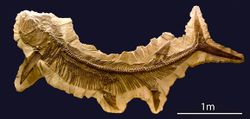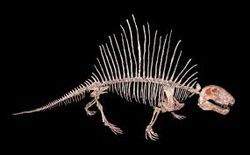Fossils/Vertebrates
Revision as of 20:12, 29 November 2020 by UTF-8 U+6211 U+662F (talk | contribs) (→Superclass Agnatha (Jawless Fish) (Ostracoderms))
- Main article: Fossils
This page is incomplete. |
Subphylum Vertebrata
| Picture(s) | No pictures have been added as of yet. |
|---|---|
| Physical Description | Have a backbone and cranium. |
| Fossil Range | Evolved during the Cambrian Explosion. |
| Taxonomy | Kingdom: Animalia Phylum: Chordata |
| Adaptations Over Time | Slowly became bigger and more terrestrial. They evolved bigger jaws and stronger bones. |
Superclass Agnatha (Jawless Fish) (Ostracoderms)
| Picture(s) | 
|
|---|---|
| Common Names | Jawless fish, including lampreys and hagfish. |
| Physical Description | They lack paired appendages and jaws. They have skin but no dermal or epidermal scales. Instead of stomachs, they simply have one long gut. Cold-blooded (ectothermic). Two-chambered heart. They have seven or more paired gill pouches. Possess a notochord (a cartilage-like rod that is a characteristic feature of all chordates in at least one stage of life) during their larval and adult stages. They possess a photoreceptive parietal eye for regulating circadian rhythm and body heat. The skeleton is made of cartilage. |
| Fossil Range | Cambrian Explosion to present-day. |
| Taxonomy | Agnatha is split up into Cyclostomata (extant and comprising lampreys and hagfish, ~120 species), Conodonta (extinct), and Ostracoderms (extinct). Sister taxon to Gnathostomata (jawed vertebrates). rRNA and mtDNA data suggest that Cyclostomata is monophyletic. |
| Mode of Life or Habitat | Cold marine waters from 10 meters deep at high latitudes to 1300 meters at low altitudes. Lampreys feed on other fish and mammals. Hagfish are scavengers. No known parental care, fertilization is most likely external. |
| Distribution | Worldwide, except for tropics and polar regions. |
| Etymology | Ancient Greek for "without jaws." |
| External Links | https://en.wikipedia.org/wiki/Notochord. https://en.wikipedia.org/wiki/Agnatha. https://en.wikipedia.org/wiki/Parietal_eye. |
Class Placodermi (Armored Jawed Fish)
Class Chondrichthyes (Cartilaginous Fish)
Superorder Selachimorpha (Sharks)
Superorder Batoidea (Rays)
Class Actinopterygii (ray-finned)
Class Sarcopterygii (lobe-finned)
Class Amphibia (Amphibians)
Class Reptilia (Reptiles)
Order Crocodilia (crocodiles)
| Picture(s) | 
|
|---|
Order Testudines (turtles)
| Picture(s) | 
|
|---|
Order Icthyosauria (Ichthyosaurs)
Order Squamata
| Picture(s) | No pictures have been added as of yet. |
|---|
Order Plesiosauria (Plesiosaurs & Pliosaurs)
Order Pterosauria (Pterosaurs)
| Picture(s) | 
|
|---|
Clade Dinosauria (Dinosaurs)
| Picture(s) | No pictures have been added as of yet. |
|---|
Order Saurischia (lizard-hipped)
| Picture(s) | 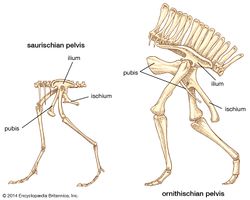
|
|---|
Suborder Theropoda
| Picture(s) | No pictures have been added as of yet. |
|---|
| Picture(s) | 
|
|---|
| Picture(s) | 
|
|---|
| Picture(s) | 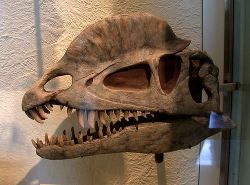
|
|---|
| Picture(s) | 
|
|---|
| Picture(s) | 
|
|---|
| Picture(s) | 
|
|---|
Suborder Sauropodamorpha
| Picture(s) | No pictures have been added as of yet. |
|---|
| Picture(s) | 
|
|---|
| Picture(s) | 
|
|---|
| Picture(s) | 
|
|---|
| Picture(s) | 
|
|---|
Order Ornithischia (bird-hipped)
| Picture(s) | No pictures have been added as of yet. |
|---|
Infraorder Anklyosauria
| Picture(s) | No pictures have been added as of yet. |
|---|
| Picture(s) | 
|
|---|
Infraorder Ceratopsia
| Picture(s) | No pictures have been added as of yet. |
|---|
| Picture(s) | 
|
|---|
| Picture(s) | 
|
|---|
Infraorder Ornithopoda
| Picture(s) | No pictures have been added as of yet. |
|---|
| Picture(s) | 
|
|---|
| Picture(s) | 
|
|---|
| Picture(s) | 250px |
|---|
Infraorder Pachycephalosauria
| Picture(s) | No pictures have been added as of yet. |
|---|
| Picture(s) | 
|
|---|
Infraorder Stegosauria
| Picture(s) | No pictures have been added as of yet. |
|---|
| Picture(s) | 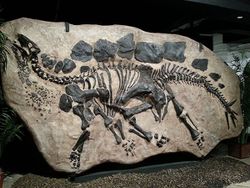
|
|---|
Class Aves (Birds)
| Picture(s) | No pictures have been added as of yet. |
|---|
| Picture(s) | No pictures have been added as of yet. |
|---|---|
| Physical Description | A feathered dinosaur that could be the size of a bluejay to a chicken. Looked similar to a theropod other than the fact that it had feathers. |
| Fossil Range | Late Jurassic |
| Distribution | Europe |
| Picture(s) | No pictures have been added as of yet. |
|---|---|
| Physical Description | Large flightless carnivore bird. It could reach heights of about 2.5 meters and usually weighed around 150kg. It can most easily be recognized by its large skull and hooked beak. |
| Fossil Range | Pliocene-Early Pleistocene |
| Distribution | North America |
| Picture(s) | No pictures have been added as of yet. |
|---|
Clade Synapsida
| Picture(s) | No pictures have been added as of yet. |
|---|
Mammal-like Reptiles
| Picture(s) | No pictures have been added as of yet. |
|---|
Class Mammalia (Mammals)
| Picture(s) | No pictures have been added as of yet. |
|---|
| Picture(s) | No pictures have been added as of yet. |
|---|
| Picture(s) | No pictures have been added as of yet. |
|---|
| Picture(s) | No pictures have been added as of yet. |
|---|
| Picture(s) | No pictures have been added as of yet. |
|---|
| Picture(s) | No pictures have been added as of yet. |
|---|
| Picture(s) | No pictures have been added as of yet. |
|---|
| Picture(s) | No pictures have been added as of yet. |
|---|
| Picture(s) | 250px |
|---|---|
| Physical Description | About as large as a modern Asian elephant - 2.5 - 3 meters tall at the shoulder. The teeth consisted of a series of plates surrounding a dentine core. They were held together in a matrix of dental cement. |
| Fossil Range | Early Pliocene-Early Holocene |
| Mode of Life or Habitat | They ate grasses, fruits, shrubs, etc. Baby mammoths ate the dung of the adults. |
| Distribution | North America, Eurasia. |
| Additional Information | The name means “earth” from the Tartar word “mamma.” |













